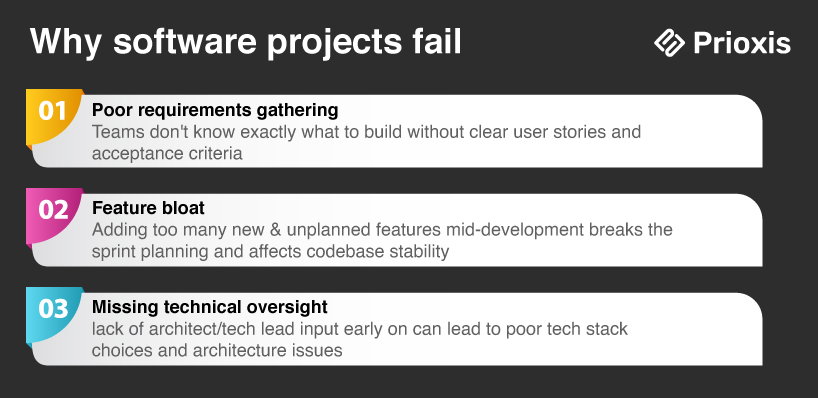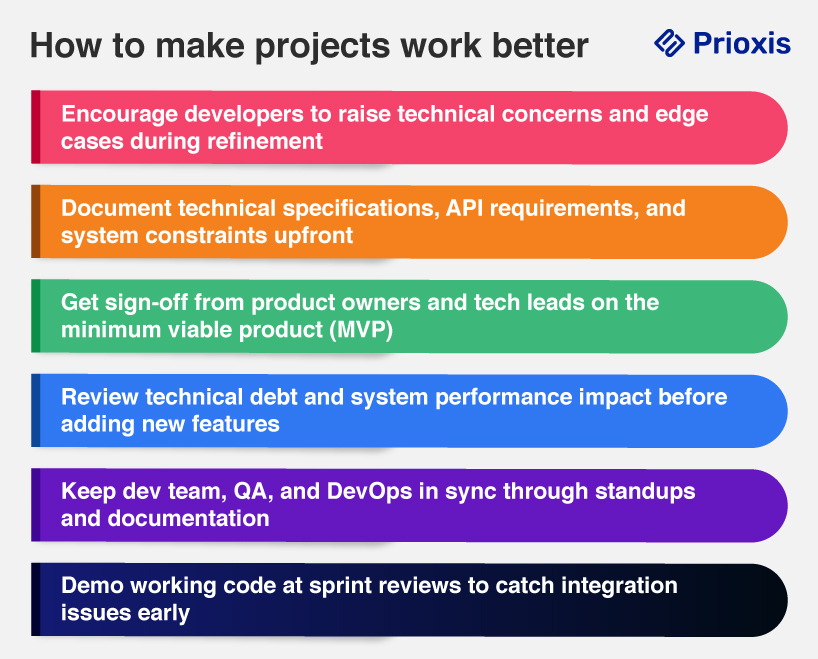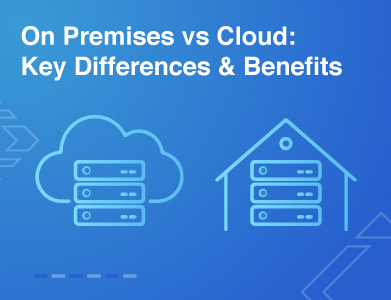Top 10 Software Development Best Practices
 Admin
Admin Software Development
Software Development Oct 25, 2024
Oct 25, 2024

Table of Content

Priyanshi Patel
Priyanshi Patel is a .NET developer with a keen interest in exploring the ever-evolving world of technology. After work, she dedicates her time to writing about the latest trends and advancements in .NET development, sharing insights on cutting-edge technologies and development practices.
Ever wonder why some software teams move fast while others keep fixing the same bugs? The solution is simpler than you think.
You wouldn't build a house without a blueprint, so why rush into building software without proven best practices? Whether you're a developer writing code or a business building a software product, following best practices helps you save time, money, and stress.
The numbers highlight just how important this is: 31.1% of software projects in the IT industry are canceled before completion, and 52.7% go over budget by 189%. IT leaders are all too familiar with this struggle, with 75% expecting their projects to fall short.
Think about it: how often do you go back to fix old code? Or look at your past work and wonder, "What was I doing?" Best practice can help you prevent this, keeping your team on track and your project within scope.
Why Software Projects Fail:

Let’s see how small changes in your software development process can turn your software projects from a hassle into a winning strategy. Ready to learn more?
How to make projects work Better:

Top 10 Software Development Best Practices
1. Requirements Gathering
Begin by getting a clear understanding of the project's needs. The foundation of any project lies in understanding stakeholder needs and translating them into actionable specifications. To do this effectively:
- Collaborate closely with stakeholders to clarify objectives and expectations, following industry best practices for bespoke software development.
- Document thoroughly. Write down everything—keep it simple and precise to ensure all requirements are clear. This aligns with software development best practices.
- Use good software engineering practices like Agile methodologies such as user stories and backlog grooming to translate high-level needs into actionable tasks.
- Prioritize needs by focusing on the most important tasks that will provide the most value.
- Validate with stakeholders to avoid misinterpretation and ensure accuracy throughout.
This establishes that development begins with a crystal-clear understanding of what is to be built, following agile software development best practices.
2. Design Principles
Good software needs good design for scalable, adaptable, maintainable and future proof software.
Follow software engineering best practices like the SOLID principles to create loosely coupled and highly cohesive code:
- Single Responsibility Each part of your program should have one clear job.
- Open/Closed Design your code to be open for extension but closed for modification.
- Liskov Substitution Ensure subtypes can replace their base types without issues.
- Interface Segregation Break up interfaces into smaller, more focused ones.
- Dependency Inversion Depend on abstractions, not concrete implementations.
Use design patterns to solve common software problems:
- Factory For flexible object creation
- Singleton To control instance management
- Observer For efficient event handling
- Strategy To swap out different algorithms easily
Keeping your design simple, modular, and scalable is one of the good practices in software development, making it easier to accommodate future changes.
Example: Strategy Pattern in Java
interface Payment {
void pay(int amount);
}
class CreditCardPayment implements Payment {
public void pay(int amount) {
System.out.println("Paid with Credit Card: " + amount);
}
}
class PayPalPayment implements Payment {
public void pay(int amount) {
System.out.println("Paid via PayPal: " + amount);
}
}
class PaymentProcessor {
private Payment paymentMethod;
public PaymentProcessor(Payment paymentMethod) {
this.paymentMethod = paymentMethod;
}
public void executePayment(int amount) {
paymentMethod.pay(amount);
}
}
// Usage
PaymentProcessor processor = new PaymentProcessor(new CreditCardPayment());
processor.executePayment(500);
This pattern helps you easily switch between payment methods without changing the overall code structure.
3. Code Organization
Readable, maintainable code is essential for collaboration and future growth. To achieve this while following software development practices:
- Break up code into logical modules from large projects into smaller ones.
- Use naming conventions that are clear and descriptive, adhering to software development best practices.
- Adopt a consistent directory structure, group by features or components so everyone can locate files easily.
- Feature-driven development, ensuring modular code for easier feature rollouts or A/B testing.
This approach aligns with good software development practices, minimizing technical debt and making the project easier to manage in the long run.
4. Version Control
Version control tools, like Git, provide a safety net and promote team collaboration. Following software development best practices, consider these key points:
- Write meaningful commit messages that summarize the intent of changes.
- Branch strategically, keeping the main branch stable while experimenting in feature branches—this is an essential software development good practice.
- Merge regularly to avoid conflict build-ups and keep everyone aligned.
Bash
# Example of creating a feature branch and committing changes git checkout -b feature/payment-integration git commit -m "Add payment integration feature" git push origin feature/payment-integration
Version control is one of the core industry best practices for software development, making collaboration easier and avoiding conflicts when multiple developers are working on the same codebase.
5. Testing
Testing ensures that your software works as intended. Implementing proper testing frameworks helps catch bugs early. The keys to successful testing, as per good software engineering practices, are:
- Test-Driven Development (TDD) ensures your code is both reliable and covered from the outset, a key software development best practice.
- Adopt Behavior-Driven Development (BDD) to create clear, business-readable tests.
- Focus on unit tests for individual components, followed by integration tests for system interactions.
Example: Unit Test in JavaScript using Mocha
JavaScript
const assert = require('assert');
function add(a, b) {
return a + b;
}
describe('add()', function() {
it('should return 4 when adding 2 + 2', function() {
assert.equal(add(2, 2), 4);
});
});
Automating tests to continuously verify your code is essential for ensuring quality, aligning with industry best practices for software development.
6. Security
Security should be part of the development process, not an afterthought. As part of good software engineering practices:
- Validate inputs rigorously to prevent injection attacks like SQL Injection or XSS.
- Keep dependencies updated to protect against known vulnerabilities.
- Run security audits regularly and employ software development best practices like encryption and role-based access control.
- Use authentication tokens like JWT to secure your APIs.
- Implement DevSecOps practices to include security checks in your CI/CD pipelines.
Example: Basic JWT Authentication in Node.js
Javascript
const jwt = require('jsonwebtoken');
function generateToken(user) {
return jwt.sign({ id: user.id }, 'secretKey', { expiresIn: '1h' });
}
Security is an important part of software development good practices and helps protect your system from unauthorized access.
7. Performance Optimization
Optimizing performance helps software run smoothly under heavy loads. Following software development best practices, performance can be improved by:
- Profiling your code to identify performance bottlenecks and optimizing the most critical areas.
- Caching frequently accessed data to avoid redundant database calls, which is a common good software engineering practice.
- Utilizing asynchronous processing to improve response times in high-traffic environments.
- Optimizing database performance using indexing, caching, and lazy loading techniques.
Example: Caching with Redis in Python
Python
import redis r = redis.Redis() def get_data(key): cached_data = r.get(key) if cached_data: return cached_data # Fetch data from DB or API data = fetch_from_db(key) r.set(key, data) return data
Regular performance testing ensures your application runs efficiently, even at scale. Whereas caching improves performance by reducing database load.
8. Documentation
Clear and detailed documentation is essential for team members and future developers to understand your project’s details:
- Document high-level architecture, write clear documentation for APIs, explaining what each endpoint does.
- Add comments in the code where necessary for explaining complex algorithms but avoid over-commenting.
- Automate documentation with tools like Javadoc or Doxygen to keep it updated.
Python
def calculate_discount(price, discount): """ Calculates the discounted price. Args: price (float): The original price. discount (float): The discount percentage. Returns: float: The final price after applying the discount. """ return price - (price * discount / 100)
This makes the code easier for others to understand, minimizes knowledge gaps and supports long-term maintainability.
9. Continuous Integration/Deployment (CI/CD)
CI/CD practices help in automating the software lifecycle from build to deployment.
- Automate builds and tests to ensure that code is always deployable.
- Set up pipelines using tools like Jenkins or GitLab CI.
- Containerize applications using Docker for consistent deployment environments.
- Use Kubernetes or similar orchestration tools to manage deployments at scale.
Example: Simple Jenkins Pipeline
Groovy
pipeline {
agent any
stages {
stage('Build') {
steps {
sh 'mvn clean package'
}
}
stage('Test') {
steps {
sh 'mvn test'
}
}
stage('Deploy') {
steps {
sh 'deploy.sh'
}
}
}
}
By automating deployment, you reduce downtime, increase reliability, and push features faster, as part of software development good practices.
10. Code Review and Refactoring
Regular code reviews help keep code clean and efficient:
- Use tools like GitHub or GitLab to review changes before they are merged.
- Refactor old code to improve structure and remove technical debt.
Regular code reviews & code refactoring in software development help you in maintaining consistency in terms of clean line of codes and catch issues early. Here's how:
- Refactor old code to improve structure and remove technical debt.
- Use tools like GitHub or GitLab to review changes before they are merged.
- Focus on readability, maintainability, and identifying areas that could lead to future issues.
Bash
# Start a pull request for review git push origin feature/bug-fix # Create a pull request on GitHub for team review
Regular reviews catch issues early and improve code quality over time without accumulating unnecessary complexity.
Wrapping Up
In this article, we talked about how following best practices in software development leads to creating better, safer, and high-quality software. Important steps like having clear requirements, choosing the right methodology, using good frameworks, keeping proper documentation, tracking issues, managing versions, and doing thorough testing all play a big role in making development successful. These practices save costs, improve security, and lead to happier customers. By sticking to these guidelines, developers can avoid common mistakes and deliver reliable, easy-to-maintain, and user-friendly software.
If you're looking for a full-stack software development agency that follows software development best practices, consider Prioxis Technologies. We've completed over 100+ successful software development projects and are a trusted provider.
Get in touch
Latest Posts









